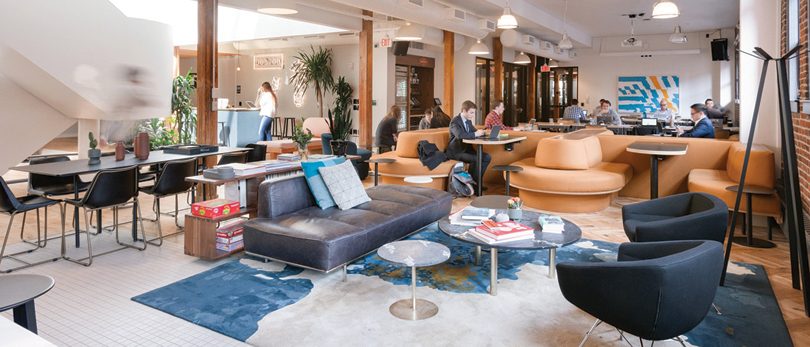Co-working spaces provide amenities and networking opportunities
By Gwen Moran
Co-working spaces are popping up all over the place. These convenient, affordable and often stylish workspaces are one of the biggest trends in commercial real estate. Trends and forecasting firm Small Business Labs predicts that there will be more than 30,000 global co-working spaces with about 5.1 million members by 2022.
For REALTORS®, co-working spaces offer a flexible home base. William Tong, CRS, broker and team leader at Golden Land Investments & Financial, Inc., in Pasadena and Arcadia, California, decided to work in a co-working space in the fall of 2017, after growing his team from three to five people. The team now has 12 associates. His team members wanted an upscale office space with access to conference rooms where they could meet clients.
By the Numbers
There will be more than 30,000 global co-working spaces with 5.1 million members by 2022.
Source: Small Business Labs
Originally, he looked at traditional office spaces, including one front-runner next to a bookstore. Then he began checking out co-working spaces, including those operated by Regus, Epic Spaces, WeWork and others. WeWork offered a beautiful space and the largest network of offices around the world.
Golden Land serves upscale clients, investors and first-time homebuyers, so having an attractive space was important to the team. “The elegance and thoughtfulness of the designed spaces was something that we could not have implemented easily,” he says. William found a flexible and beautiful space to grow his team’s business and he was able to shift office renovation money toward serving his clients.
Amenities Galore
One of the appealing aspects of co-working spaces is the amenities that are available. At 36 Degrees North, a co-working space in Tulsa, Oklahoma, a base membership is $149 per month. The space has a fresh, modern décor and a variety of workspace options ranging from workstations in an open-space floor plan to small meeting “pods” that seat two or three people to various conference rooms and meeting spaces. The space also has a kitchen and restrooms, and the conference rooms are equipped with Wi-Fi, white boards, televisions and other features.
“The cost of renting an office, paying for utilities, furniture, maintenance, coffee, printers, etc., adds up quickly,” says Lauren King, communications manager of 36 Degrees North. “And if you think about it, REALTORS® spend a good chunk of their time out of the office anyway—so why invest so much in the space? They could still have a consistent landing place but at a much lower cost,” she says.
Creating Connections
Tong says having an impressive office has paid off for him. When a prospect flew from Shanghai to Pasadena, Tong was able to schedule a conference room in the Santa Monica WeWork location near his hotel. “He was really impressed by the space and the way we answered his questions,” Tong says. “The team and I helped him buy a great property that week. We rented it out for him a week later.”
Co-working spaces also offer an opportunity to meet new prospects. While his goal was not to cultivate business there, fellow tenants have entrusted Tong with their business. Another perk: The office overlooks the route for the Rose Bowl Parade. Each New Year’s Day, the office is filled with WeWork members and their families, clients and friends watching the parade and sipping peppermint hot chocolate.
Of course, it’s not all a bed of roses. Co-working spaces can be noisy. The Golden Land team’s office isn’t large enough to accommodate a printer, so they rely on WeWork’s printers, which occasionally are down. And once another REALTOR® brokerage rented the space right next to his team, so the team had to be careful about what they discussed in their own office.
Moving to a Co-working Model
REALTORS® are also adopting aspects of the co-working model. After the recession, Edna Taylor, CRS, broker/owner of McAllen Realty Services in McAllen and Edinburg, Texas, converted her real estate business’ space to executive offices, renting to individuals or small businesses. She counts an insurance agent, accountant and placement service among her tenants. “This executive office concept allows interaction between tenants. I have sold homes to the tenants and their friends,” Taylor says. “Networking with different business professionals is a great asset for understanding the economic impact in the Valley.”
Don Mayes, CRS, who is also a corporate broker for Keller Williams Realty of Mobile and Baldwin counties in Alabama, has various workspaces available to the REALTORS® in his office. Lively exchanges take place in the open space they may use. “Private office space is available for agents who need—and are willing to pay for—that closed door and the sanctuary it provides,” Mayes says.
The combination of turnkey workspaces, amenities and networking opportunities makes both commercial and REALTOR®-specific co-working spaces an attractive option.
Ask Away
Before you sign up for a co-working space, here are some questions you should ask:
What’s included in my fee or subscription?
You may be entitled to a certain number of hours of conference room space or other amenities, says Lauren King, communications manager of 36 Degrees North, a Tulsa, Oklahoma co-working space.
Who else is here and who can I get advice from?
Talk to people who have rented co-working spaces. Get to know the other co-working members, figure out how to add value and network with them. William Tong, CRS, broker and team leader with Golden Land Investments & Financial, Inc., in Pasadena and Arcadia, California, has developed both friendships and business relationships at his co-working space.
What events do you have?
Many co-working spaces offer networking events, seminars and other opportunities to meet or learn from other business owners.
Thinking about a co-working solution for your office? Check out our available classes on how to use cloud computing to help you run your business. Find out more at crs.com/learn.








